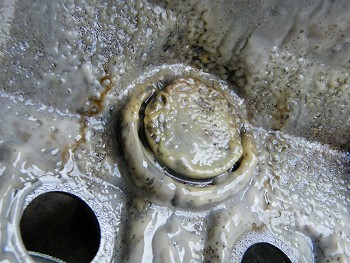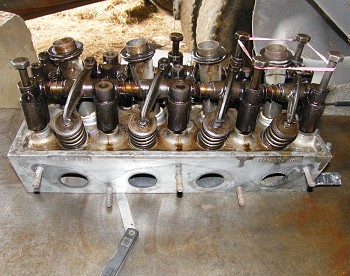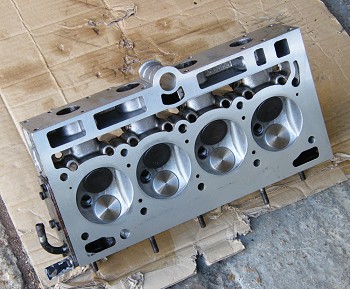Head Gasket Failure
That's the danger of completing a car on the evening before a long drive. There's no time to take progressively longer trips to make sure everything is working properly.
It turned out things were not working properly. It was only on the way back from the annual Renault 4 run in Kent that I realised the head gasket had blown. There were no overheating problems, but the car was using water, and that water was ending up in the oil. The dip stick was covered in mayonnaise, and the photo shows nasty scum on the inside of the rocker cover.
I don't think this head has been removed in the past. The Renault 5 Gordini that I stole the engine from had recorded 68,000 miles, and the engine had seemed to be in good condition so I didn't take it apart.
It is possible the engine may have had head gasket problems when it last ran. The car had come with a spare engine which is always a bad sign.
Indeed the engine does seem to be in good condition - the original honing marks are visible in each cylinder.
Heads are difficult to check for straightness on a DIY basis. Using a ruler as a straight edge won't pick up any warping as the ruler will bend sideways to take up any distortion. A known straight edge that can't bend might work.
There was a surface table kicking around in a barn that I used for checking if the head was straight. Surface tables are astonishingly flat when new. Mine is at least 60 years old so is likely less flat.
The tolerance for head distortion is 0.05mm, and I measured 0.12mm between the front two cylinders. A measurement taken elsewhere on the table gave a 0.08mm reading, but the worst point was at the same place on the head. A skim is only £30, but I had been hoping to avoid it as the 10.25:1 compression ratio on this engine should already be too high for modern petrol (though it never pinks).
I wasn't happy with one of the exhaust valves as the seating face on the valve appeared to have worn. The other valves have scoring in the faces. Information about this engine is tricky to find but it is from a similar era to my Renault 4 1108 engines, and judging from the wear I suspect it is not suitable for unleaded petrol (the 1108 engines need additive for motorway driving).
Hardened valve seats are easy, but valves are proving difficult to find. They might be available from French or German suppliers. I am writing to them in English but in capitals which is the internet equivalent of speaking loudly.
I bought the valves from mecaparts.com in France, though simon-auto.de and renaultpower.com in Germany also supply them.
The head was also treated to hardened exhaust valve seats, a 0.1mm skim, and a good wash. It looks so nice it seems a pity to fit it to the engine.
The head fettling was done by T&L Engineering in Bedford. A reasonable expense, but it'll be nice not having the exhaust valves disappear into the head after a long motorway trip - I can never remember to put the additive in.
Whoops - After refitting the head and refitting the engine water was still finding it's way into the oil. The head had been a pain to remove - it had needed a 4 foot bar to move it sideways to break the gasket seal, and I think that must have dislodged a liner seal. Apparently that's easily done with the 1397cc engines that have rubber o-ring seals rather than the earlier paper seals.
So next job was to remove the engine. See the engine rebuild pages for the next episode.
Update: Uurm, don't forget to get your head crack tested before rebuilding it - that turned out to be the fault here.
Next> Engine rebuild or back to the Gordini Project










